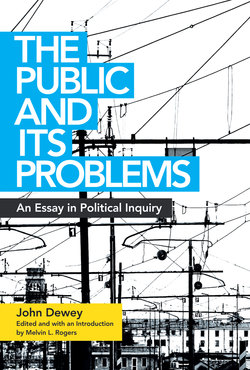Читать книгу The Public and Its Problems - Джон Дьюи - Страница 9
На сайте Литреса книга снята с продажи.
ОглавлениеEditorial Note
The present version of The Public and Its Problems reprints the 1954 edition by Swallow Press, now an imprint of Ohio University Press. The 1954 edition includes the Introduction (titled “Afterword” in that edition) that John Dewey wrote for the Gateway Books edition published in 1946 in Chicago. The present version, however, also includes the subtitle that Dewey appended to the Gateway Books edition, thus providing the full title: The Public and Its Problems: An Essay in Political Inquiry. All of these editions, excluding the substantive additions from 1946, are reprints of the 1927 book published by Henry Holt and Company of New York City. That initial book was in print from 1927 to 1941, and the decision to discontinue its publication was largely due to diminishing sales.
This is the second reprint of The Public and Its Problems for which I have served as editor. The first version, published by Pennsylvania State University Press in 2012, was discontinued in 2015. Pennsylvania State University Press allowed me to honor the initial agreement between Roberta Lowitz Grant (Dewey’s second wife) and Alan Swallow that granted Alan Swallow exclusive rights to The Public and Its Problems. All of the content found in the Pennsylvania State University Press volume (which I shall comment on in a moment) has now been moved over to this edition. This present volume thus replaces the Pennsylvania State University Press 2012 edition and updates the 1954 edition published by Swallow Press.
The only other version of this text in print is the Southern Illinois University Press edition as found in The Later Works of John Dewey, 1925–1953, vol. 2, published in 1984. This reprint differs from the Southern Illinois University Press edition in the following notable ways. The Southern Illinois volume contains full publication information for most of the texts cited by Dewey, the content of which was drawn either from The Public and Its Problems or from Dewey’s personal library as found in John Dewey’s Personal and Professional Library: A Checklist, compiled by Jo Ann Boydston (Southern Illinois University Press, 1982). Unlike the Southern Illinois University reprint of The Public and Its Problems, however, this volume fully incorporates that information into Dewey’s original notes so that the main text and notes are continuous. Further, in instances where citation to a particular edition is not included either in The Public and Its Problems or in Dewey’s personal and professional library, this version provides that information with reference to the most recent edition of the work cited, thus rendering the reprint more complete.
Additionally, I provide informational notes that are otherwise missing from the Southern Illinois volume. My rule has been to supply a note wherever a modern reader might reasonably stop for an explanation or description that Dewey does not provide or might wonder about the full passage of a text from which Dewey quotes. In especially important cases, I have referred the reader to other works by Dewey that might provide further illumination on the subject matter at hand in the text. This now provides the reader with connective tissue among the ideas that are on offer in The Public and Its Problems and the earlier or later iteration of those ideas in Dewey’s corpus.
In all cases above, I have tried to limit my editorial additions, relying whenever possible on the argumentative context and the reader’s general knowledge. As a result, some decisions regarding what was worthy of an informational note inevitably cannot escape the risk of appearing arbitrary. I have tried to be careful not to overburden the reader. In every instance, the aim is to provide a richer and more useful volume than currently exists. In some instances—although very few—it was simply impossible to locate a source to which Dewey referred. In other instances, Dewey refers to traditions of thought far too diffuse to attribute to a specific source. In such cases, I have provided no additional information. The annotations coupled with the Introduction, Chronology, and Bibliographical Essay are all meant to aid both student and researcher in their engagement with this most important work by John Dewey.
Dewey’s own notes appear as asterisked footnotes. My notes are signaled by superscript arabic numerals. In some cases, I have appended, in square brackets, comments after Dewey’s notes consistent with the approach outlined above.
All selections from Dewey’s writings are taken from The Early Works of John Dewey, 1882–1898 (abbreviated EW), The Middle Works of John Dewey, 1899–1924 (MW), and The Later Works of John Dewey, 1925–1953 (LW), edited by Jo Ann Boydston (Carbondale: Southern Illinois University Press, 1969–83). All references to Dewey’s works appear in notes. Citations include title, series abbreviation with volume number, and the page number(s) (e.g., The Quest for Certainty, LW 4:214).
This edition retains Dewey’s original punctuation and spellings from the 1954 Swallow Press edition, except for the correction of obvious typographical errors. These amendments will be made without explicit remark. Dewey often uses rare or archaic variants of words, which have not been modernized in this edition; none of the words disrupt the meaning of the sentences in which they occur. In a limited number of cases, I have emended punctuation or supplied a missing word in square brackets. Occasional syntactical infelicities still remain. In the case of a few sentences that are awkwardly constructed, rendering the meaning vague, I have provided a note of clarification that includes guidance on Dewey’s likely intended meaning.
